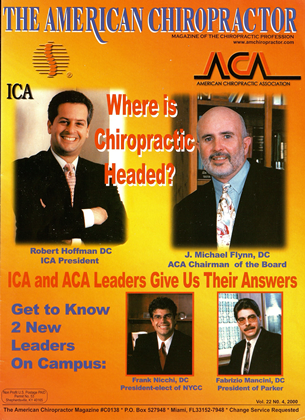New York Chiropractic College's Board of Trustees has selected New Hyde Park resident, Dr. Frank Nicchi, to be the next President of the College. Dr. Nicchi will assume the duties of the presidency on September 1, 2000. He succeeds Dr. Kenneth Padgett, who has been President since 1989, and had announced his intention to retire. Dr. Nicchi completed his Bachelor's degree at St. John's University in 1973, attended National College of chiropractic and received his D.C. from New York Chiropractic College in 1978. In 1980, he was appointed to the faculty of New York Chiropractic College and has served as an assistant and associate professor of clinical sciences instructing orthopedics, clinical neurology, differential diagnosis and flexion-distraction technique. Additionally, he has served as a clinician to chiropractic interns at the college s out-patient facilities and, currently, as Dean of Postgraduate and Continuing Education. A Fellow of the American and International College of Chiropractors, Dr. Nicchi is a past member of the Board of Directors of the New York State Chiropractic Association, the recipient of the New York Chiropractic College 1997 "Chiropractor of the Year", and a noted postgraduate seminar and convention speaker. Dr. Nicchi has lectured nationally and abroad with presentations at multidisciplincirv conferences including the American Back Society, the Florida Back Institute, the Hospital for Joint Diseases Spine Center, and has conducted cooperative seminars on pain management with the late Janet Travel!, M.D. He has been a practicing chiropractor in New York State for over 20 years, having actively practiced chiropractic in offices located in Queens and Long Island, NY, in addition to his career in academia. , . . . TAC: Dr. Nicchi, what motivated you to assume the position of New York Chiropractic College President? FJN: I know the college intimately and have viewed it from a number of unique perspectives over the past 20 years, including those of: matriculating student, faculty member, clinician, and administrator. I have served the College's interests as a member of the New York State Chiropractic Association, and as a liaison selected to meet with state legislative and regulatory bodies. TAC: In your position as the President of NYCC, what is your vision of the future of the college? FJN: I intend to sustain the school's excellent academic track record and to strengthen ties with our alumni throughout the world. In addition, I will support rigorous scholarly and scientific research and will work to communicate the many benefits offered by chiropractic. The College will commit its energies to helping introduce chiropractic to the public consciousness. The future of New York Chiropractic College hinges directly upon strides made by New York's chiropractic profession, and by increased public utilization of our services. Our profession's greatest challenge remains that of effectively communicating the benefits of chiropractic to patients and to the public at-large. I will propose that the College execute a thorough and sustained public information media campaign-drawing upon a variety of media channels and delivering poignant and well-targeted messages. Just recently, the College completed filming a television commercial that will educate New York citizens about the important role chiropractic should play in their healthcare decisions. I will continue to aggressively support efforts by the College to "get the word out" about chiropractic. Continued growth within the profession relies heavily upon scientific confirmation of chiropractic's recognized benefits. I am confident that, through critical and systematic study, chiropractic research will yield exciting new scientific discoveries. I will encourage college involvement in a comprehensive program of practice-based research and outcomes assessments. The College currently demonstrates (through its expanded research facilities) its commitment to the validation of principles chiropractors "know" to be true. 1 will work to broaden NYCC's research efforts in an effort to extend them beyond the musculoskeletal model. Ultimately, our results should reveal how chiropractic spinal adjustments affect non-musculoskeletal and visceral conditions. Indeed, we have a professional obligation to expand our understanding of this process and to deliver our findings to the scientific community. New York Chiropractic College has implemented a bold new curriculum that offers a wide spectrum of course elec- tives and encourages student exposure to many well-regarded chiropractic techniques. Additionally, students will be permitted to perform spinal adjustments earlier in their educational experience. This step should heighten appreciation for the relevance of fundamental courses, and provide appropriate emphasis for their clinical experience. I am committed to reaffirming NYCC's academic excellence and to further development of the school's new elective curriculum. TAC: With the already existing chiropractic colleges and associations around the world, how would you like to see NYCC involved in uniting them? FJN: A variety of chiropractic colleges and associations represents a healthy diversity within the chiropractic profession. The College is uniquely positioned to identify, explore and develop aspects that are commonly shared by practitioners. Academia has traditionally provided a context amenable to multiple perspectives, while its resources offer an efficient means to disseminate important information both within the field and to the public at-large. TAC: Do you have any advice for our chiropractic readers who are currently in practice? FJN: B.J. Palmer once warned, "When you get to the end of your rope, tie a knot in it and hang on. Chiropractic's "tight grip" and its survival instincts have become legendary. Since effective patient education is critical to the profession's continued success, practitioners are well-advised to support the many chiropractic associations and colleges offering valuable communications venues for the dissemination of information relevant to advances in chiropractic research and patient care. To contact New York Chiropractic College, call 1-888-354-6528 or 973-335-2590. Frank J. Nicchi
 View Full Issue
View Full Issue






